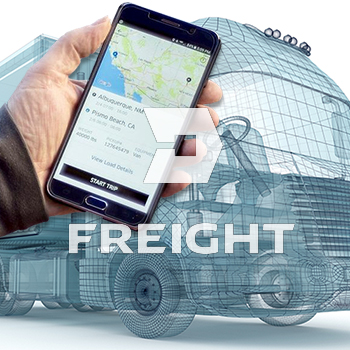It basically goes without saying that changes are coming in regards to the frenetic pace of technological innovation in the world of truckload brokerage.
Last week’s news that Uber has officially become a player in the space, with the introduction of its Uber Freight app, created a ripple effect of sorts.
Where was this ripple effect?
Personally speaking, there was a bit of one in my e-mail inbox, with pitches from other like-minded digital freight matching/brokerage players clearly stating: “hey, we are here, too.”
Yes, we know you are out there. In fact, at this point, it may be easier to wonder who is not out there?
Back to the Uber Freight app for a minute. As we reported, Eric Berdinis, Uber Freight Product Manager, wrote in a blog posting that “vetted users download the app, search for a load, and tap to book it, which is followed by a rate confirmation within seconds that eliminates a common anxiety in trucking about whether or not a load is really confirmed.”
And in an interview, he explained to me that Uber firmly believes it can make a significant impact in the future of trucking with a new way of booking freight and a new way of connecting small fleets and owner-operators with the large tail of capacity out there in the market to the community of shippers that don’t traditionally have the resources to go out and find capacity.
He added that small fleets, with ten trucks or less, make up 90 percent of the registered motor carriers in the country, but a large Fortune 500 or mid-market company would not be contracting with these small fleets.
By building an app, Berdinis contends Uber believes it can finally reach into that carrier pool and be welcoming and provide trust to the small fleets, with those fleets bringing the same level or higher service to shippers.
Digital Logistics
As critical as the connected truck will be in bringing sweeping changes to the global transport of goods, its very connectivity will allow it to be fully integrated into the entire logistics effort. That in turn will fully enable two key elements of the effort: the integrated digital supply chain and freight matching.
- The integrated supply chain. It will soon be possible to integrate the truck into real-time logistics data across the entire supply chain, from parts and materials suppliers to manufacturers to warehouses and distributors and finally to the end customer. Thus, for example, when a customer sends an order to a manufacturer, the system will send back a report on the availability of the goods and timing of shipment, enabling the manufacturer to optimize its just-in-time production schedule. Once the goods are available, the shipment will be dispatched from the warehouse along a predetermined route. If an accident or heavy traffic impedes the on-time arrival of the truck, the system can automatically determine a new route, and send a new estimated delivery time to both the shipper and the customer. Given the delay, the system will then calibrate changes in the shipping rate and cost of the goods. Moreover, manufacturing customers whose goods are delayed will be able to make immediate changes in their production sequences to avoid loss of production capacity while waiting for the missing parts. All that’s needed now is their approval of the changes.
- Automated freight matching. Thanks to their ability to communicate with fleet management and with shippers of goods - and in the future with cloud-based solutions for freight matching - trucks will eventually be able to determine whether they can take on additional freight. The truck trailer itself will be able to determine through sensors its available space and weight, as well as scheduled route, ETA, and other relevant information, and communicate this data to a digital freight-matching platform.
Freight-matching information flow
In turn, the platform will notify the driver and fleet management about available freight-sharing opportunities, and an agreement can be struck between the truck operator and the shipper. Ultimately, with the aid of smart cloud-based solutions, goods sitting in a warehouse equipped with their own communication chips will be able to contact trucks directly to find their own transportation to their intended destination. At this stage, not only will the efficiency gains throughout the supply chain be significant, but freight brokers themselves will no longer be necessary, as standard logistics processes will be digitized all the way through to when the invoice is submitted to the customer.
A True Disruptive Influence
This all sounds pretty good, but as previously mentioned, this is a crowded marketplace, with new entrants popping up daily or so it seems.
What’s more, it also reinforces the thesis that Uber Freight, and other similar services, truly have the potential to serve as a true disruptive influence sector, according to Morgan Stanley analyst Ravi Shanker.
“The announcement…legitimizes the secular disruption threat that traditional brokerage business models face,” Shanker wrote in a research note.
“The Uber Freight app offers carriers ease of use, load transparency, and quick payment turnaround (7 days vs. several weeks) as main draws. For shippers, we believe Uber’s lower net revenue margins offer superior economics to those of traditional brokers. We believe this launch marks the first salvo in Uber’s trucking ambitions – in the coming years, we also expect Uber’s autonomous truck technology to leverage the carrier base built by its brokerage operation.”
“This move also marks an escalation in the truck brokerage disruption wars – thus far we have seen several startups vying to be the ‘Uber of freight’ achieve scale in the past two years, but Uber’s launch marks the entry of the first tech giant into this space, ahead of Amazon’s impending launch this summer (we hear that Amazon has already “soft launched” for internal use only).”
Shanker also observed that in the long-term his firm sees secular margin compression at all of the 3PLs given the threat of increased competition from: startups vying to crowdsource freight that continue to raise meaningful amounts of private capital; insourcing at eCommerce and other logistics giants; and vertical integration into the asset light business by asset heavy players including, eventually, OEMs.
Tommy Barnes, president of Chicago-based project44, a technology services provider offering standardized, secure Web service API (application programming interfaces) integrations, said that given the proliferation of players in this space, the best product will win, specifically the best product that interacts best with individual drivers.
“Right now there are a lot of players flooding the market and drivers see lots and lots of apps from lots of people,” he said. “It is about the best product and what that best product brings to those drivers. It is about the experience of the driver.
A lot of times folks build an app and the reality is 9 out of 10, if not more, have no understanding of what the life of a driver feels like or looks like and the ones that win have the ability to understand how their lives work. They need to understand how they can enable the driver’s life to be more efficient productive and easier, which is the end game.”
Barnes was blunt in pointing out that some players will succeed in this pace, but many will fail. And with the proliferation of companies getting involved, he said that traditional brokers are going to suffer, because they are going to have less efficiency, with an offering like Uber Freight causing margin pressure, which is gross margin pressure because they are going to be operating more efficiently through their technology and can afford to do that in many cases.
Read: The Problem with the “Uber for Trucking” Model
Another point to consider raised by Barnes is that the traditional brokerage process, which is very manual, will have a very hard time surviving.
“Some will bring on good people to be more efficient,” he said. “As an analogy, if your gross margin is 15% and your net margin is 3% it is because you are not very efficient, and you are going to have a hard time when your margins compress. But if your margins are 11% and your net is still 9-10% because your technology is that much more efficient you are going to accomplish things others cannot.”
All told, these valid points paint an optimistic picture for those with the technological know-how to differentiate themselves in a challenging and competitive environment. Only the smartest will survive.
The Era of Digitized Trucking: Transforming the Logistics Value Chain
Driven by Technology
Perhaps the best way to understand the technologies that are already being implemented in the trucking industry, and how they will transform the industry’s many stakeholders, is to break them down into two primary areas: the truck itself and the logistics chain of which it is an essential part.
The six technological advancements that will transform trucking and logistics
Download The Era of Digitized Trucking: Transforming the Logistics Value Chain
About the Author
Follow Robotics 24/7 on Linkedin
Article topics
Email Sign Up






















